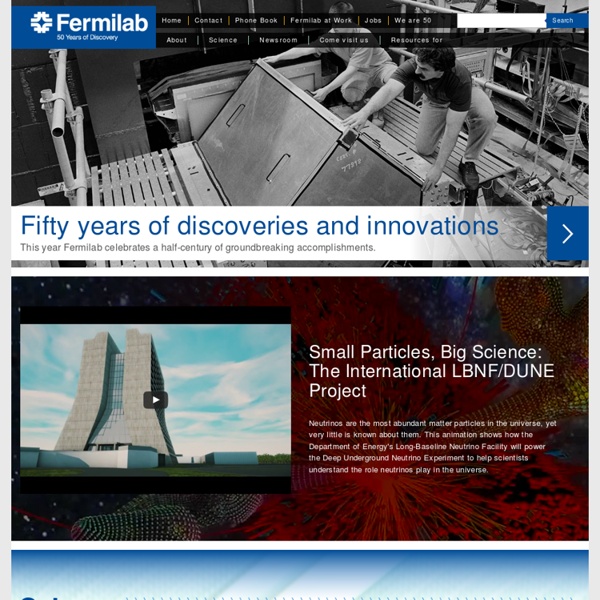



Better Nuclear Power Through Ping Pong The lab is deep-space quiet. A long, narrow hallway hung with fluorescent lights extends to my left. Four or five doors interrupt the flow of drywall. NOVA Can Wind Turbines Make You Sick? Residents living in the shadows of wind turbines say the sound is making them sick. But so far the science isn't there. From NOVA Next | Jun 27, 2018 'We Don't Planet' Episode 3: What's Up with Gravitational Lensing? The fundamental description of gravity under general relativity — that the presence of matter and energy deforms the fabric of space-time, and this deformation influences the motion of other objects — leads to a rather unexpected result: a massive object can act like a lens, magnifying and warping the images of background objects. This prediction was the first major test of general relativity, with Sir Arthur Eddington leading an expedition to measure the small (but detectable) deflection of starlight around our sun, and today this facet of our universe is used as a powerful cosmological probe. The challenge that gravitational lensing answers is the determination of mass at very large scales. Since most of the mass of the universe is composed of dark matter, we can only rely on indirect probes to measure the true mass of galaxies and clusters of galaxies.
Could cold spot in the sky be a bruise from a collision with a parallel universe? Scientists have long tried to explain the origin of a mysterious, large and anomalously cold region of the sky. In 2015, they came close to figuring it out as a study showed it to be a “supervoid” in which the density of galaxies is much lower than it is in the rest of the universe. However, other studies haven’t managed to replicate the result. Now new research led by Durham University, submitted for publication in the Monthly Notices of the Royal Astronomical Society, suggests the supervoid theory doesn’t hold up. Intriguingly, that leaves open a pretty wild possibility – the cold spot might be the evidence of a collision with a parallel universe.
Schrödinger’s Cat: Explained Erwin Schrödinger was born in Vienna on August 12, 1887 and was awarded the Nobel Prize in Physics in 1933. He is best known for his work regarding quantum theory, particularly about his thought experiment involving a cat in order to explain the flawed interpretation of quantum superposition. The Copenhagen Interpretation of quantum mechanics essentially states that an object in a physical system can simultaneously exist in all possible configurations, but observing the system forces the system to collapse and forces the object into just one of those possible states. Schrödinger disagreed with this interpretation. So what does this have to do with cats? Chinese Scientists Successfully Teleported a Particle to Space When it comes to weird quantum effects, none is weirder than quantum teleportation. Scientists can—and have—used the unique and complicated physics of quantum mechanics to instantaneously teleport small particles across great distances. Now, a Chinese team has broken the distance record by teleporting particles to a satellite in space. When we talk about teleportation, we should be clear about exactly what that means. Nobody's beaming people to space like in Star Trek.
Google's Nuclear Fusion Project Is Paying Off - Google and Tri Alpha Energy Improve Plasma Generator Tri Alpha Energy / Erik Lucero Nuclear fusion, the process the sun has used for billions of years to fuse atoms of hydrogen into atoms of helium, could be the pot of gold at the end of the clean energy rainbow. If we could engineer a reaction to snowball but remain contained, nuclear fusion reactors could supply virtually unlimited clean energy here on Earth. Yet, the technology seems perpetually just around the corner. 'Serious gap' in cosmic expansion rate hints at new physics Image copyright NASA A mathematical discrepancy in the expansion rate of the Universe is now "pretty serious", and could point the way to a major discovery in physics, says a Nobel laureate. The most recent results suggest the inconsistency is not going away. Prof Adam Riess told BBC News that an unknown phenomenon, such as a new particle, might explain the deviation.
The single strange repeating fast radio burst is at it again Fast radio bursts, or FRBs, are one of the hottest topics in astronomy right now. These intense blasts of radio energy reach us from outside the galaxy, lasting only milliseconds before they disappear once more. Astronomers aren’t sure what causes them, and none of these bursts have ever repeated — except one, FRB 121102, which made headlines with the identification of its host galaxy, sitting nearly 3 billion light-years away. The Breakthrough Listen project has just announced the detection of 15 additional bursts from FRB 121102, which has now been seen to repeat more than 150 times. Fifteen new bursts may not seem unique among such a high number, but these bursts are different. They are the first time that FRB 121102 has been seen bursting at high frequencies; and they also signal, according to Vishal Gajjar of the University of California, Berkeley, a “newly active state.”
The Quest for Absolute Zero Turns Up Strange and Surreal Superfluids Getting anything down to true absolute zero—where there is no atomic movement whatsoever—is probably a physical impossibility. But in our quest to see how cold things can get, we've come across some pretty unusual states of matter. PBS SpaceTime gets down to the molecular level for a look. Advertisement - Continue Reading Below Helium is a unique element, a bit of a loner on the periodic table in terms in how it can handle the cold. Helium-4, an isotope of helium, can remain liquid right down to the fabled absolute zero and, in fact, changes into a substance known as a superfluid.